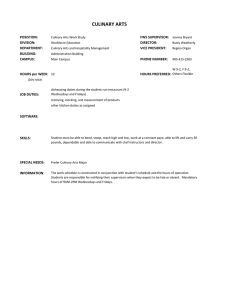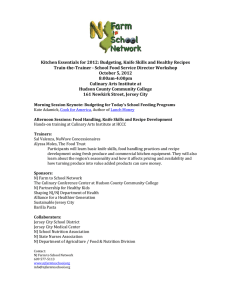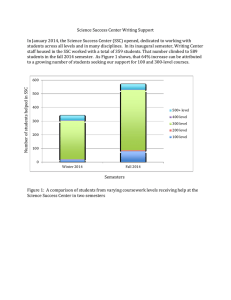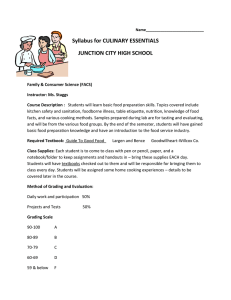Quarterly News Quarterly News
advertisement
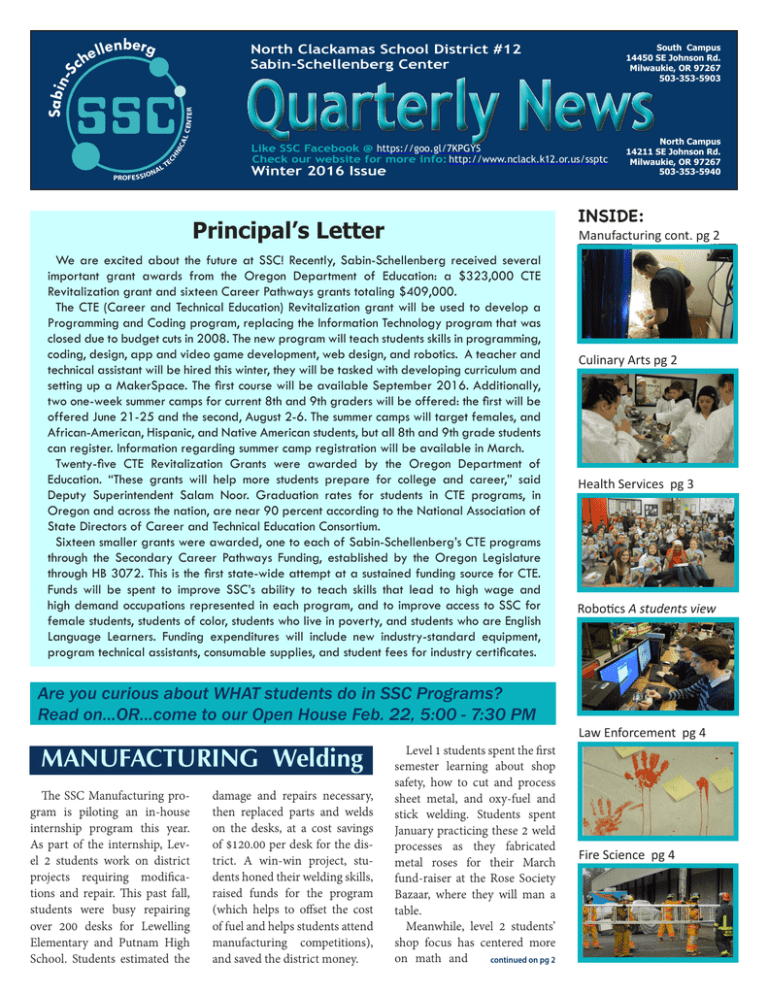
N TE R North Clackamas School District #12 Sabin-Schellenberg Center CH NI CA L CE Sabin -S nbe elle rg h c PROFES SIO NA LT E Quarterly News Like SSC Facebook @ https://goo.gl/7KPGYS Check our website for more info: http://www.nclack.k12.or.us/ssptc Winter 2016 Issue Manufacturing cont. pg 2 We are excited about the future at SSC! Recently, Sabin-Schellenberg received several important grant awards from the Oregon Department of Education: a $323,000 CTE Revitalization grant and sixteen Career Pathways grants totaling $409,000. The CTE (Career and Technical Education) Revitalization grant will be used to develop a Programming and Coding program, replacing the Information Technology program that was closed due to budget cuts in 2008. The new program will teach students skills in programming, coding, design, app and video game development, web design, and robotics. A teacher and technical assistant will be hired this winter, they will be tasked with developing curriculum and setting up a MakerSpace. The first course will be available September 2016. Additionally, two one-week summer camps for current 8th and 9th graders will be offered: the first will be offered June 21-25 and the second, August 2-6. The summer camps will target females, and African-American, Hispanic, and Native American students, but all 8th and 9th grade students can register. Information regarding summer camp registration will be available in March. Twenty-five CTE Revitalization Grants were awarded by the Oregon Department of Education. “These grants will help more students prepare for college and career,” said Deputy Superintendent Salam Noor. Graduation rates for students in CTE programs, in Oregon and across the nation, are near 90 percent according to the National Association of State Directors of Career and Technical Education Consortium. Sixteen smaller grants were awarded, one to each of Sabin-Schellenberg’s CTE programs through the Secondary Career Pathways Funding, established by the Oregon Legislature through HB 3072. This is the first state-wide attempt at a sustained funding source for CTE. Funds will be spent to improve SSC’s ability to teach skills that lead to high wage and high demand occupations represented in each program, and to improve access to SSC for female students, students of color, students who live in poverty, and students who are English Language Learners. Funding expenditures will include new industry-standard equipment, program technical assistants, consumable supplies, and student fees for industry certificates. Are you curious about WHAT students do in SSC Programs? Read on...OR...come to our Open House Feb. 22, 5:00 - 7:30 PM MANUFACTURING Welding damage and repairs necessary, then replaced parts and welds on the desks, at a cost savings of $120.00 per desk for the district. A win-win project, students honed their welding skills, raised funds for the program (which helps to offset the cost of fuel and helps students attend manufacturing competitions), and saved the district money. North Campus 14211 SE Johnson Rd. Milwaukie, OR 97267 503-353-5940 INSIDE: Principal’s Letter The SSC Manufacturing program is piloting an in-house internship program this year. As part of the internship, Level 2 students work on district projects requiring modifications and repair. This past fall, students were busy repairing over 200 desks for Lewelling Elementary and Putnam High School. Students estimated the South Campus 14450 SE Johnson Rd. Milwaukie, OR 97267 503-353-5903 Level 1 students spent the first semester learning about shop safety, how to cut and process sheet metal, and oxy-fuel and stick welding. Students spent January practicing these 2 weld processes as they fabricated metal roses for their March fund-raiser at the Rose Society Bazaar, where they will man a table. Meanwhile, level 2 students’ shop focus has centered more on math and continued on pg 2 Culinary Arts pg 2 Health Services pg 3 Robotics A students view Law Enforcement pg 4 Fire Science pg 4 MANUFACTURING continued from pg 1 A Manufacturing Student works on a chair repair welding skills from start to finish, with safety and quality control stressed. Level 2 students perfect stick and oxy-fuel while learning wirefeed and TIG welding techniques. Hands-on projects like the recent staircase and handrail work for the softball field at Riverside Park are completed. Level 3 /4 students work on advanced welding and shop skills, working independently on self directed projects. Many choose to pursue their American Welder Society Welder Qualification, a performance based certification which provides transferable welder credentials widely sought after in the structural steel, petroleum pipelines, sheet metal, and chemical refinery welding industries. In February two advanced students started interning at C Tool Weld , a local aerospace company. While there they will learn aspects of the company from sheet metal handling, weld quality inspection, and industry required employment certification. All levels of Manufacturing are gearing up for spring competitions. Students will compete at Lower Columbia Community College welding competition, CCC Regional Skills competition and Linn Benton Community College to practice their professional skills. On March 10 students from all over the state will visit the North campus to familiarize themselves with the Manufacturing equipment to be used at the upcoming State SkillsUSA contest, where students will test their skills at CNC, sheet metal, and Manufacturing student welding welding. 2 CULINARY ARTS Culinary Arts had a great start this year, with eight Introduction to Culinary classes, something was always “cookin’ in the kitchen.” As students wrapped up their first semester, it’s hard to believe all they’ve learned! It seems like only yesterday students were learning to measure properly and read recipes; now they’re preparing dishes from scratch without even needing a recipe! Intro students spent time learning to bake, basic food preparation and most importantly... safety and sanitation. Students also trained with the Oregon Restaurant and Lodging Association to earn their food handlers certification, which is valid for three years. Equipment updates and tools are currently being added to the Intro kitchen for present and future Culinarian’s use. Looking forward to new faces and adventures in Intro to Culinary second semester! Culinary 1 started the year off strong with 121 students divided between four double blocks. After orientation and a safety Intro to Culinary students learn about dough making and sanitation review, students acclimate themselves to the kitchen, where they spend 2.5 hours on their feet (some of them for the first time) following general kitchen protocols and cleaning rotations. This is where kids start to feel the difference between Intro to Culinary and the year 1 Culinary classroom. After working through all of the logistics of Culinary 1, students start with the basics. Knife skills are considered the first thing any chef should learn. As a chef, a knife is the most important tool; an extension of your hand. Each student must perfectly cut 10 of each of the 12 classic knife cuts. This is more difficult than it sounds as this year students’ set a new record...over 2000 pounds of potatoes were used learning knife skills! Chef Karsten swears that “By the end of knife skills unit I think some kids never want to see another potato!” After knife skills CA1 students move on to the foundation of all cooking; classic French methods. This unit includes classic sauces, starch and grain cookery as well as cooking methods for proteins and vegetables. This is where students learn techniques that will allow them to move beyond the recipe. At the end of this unit students are required to recreate a Black Box; a dish without a recipe. Culinary 1 students also spend many hours completing their restaurant management project. Utilizing an in-depth program called Virtual Business Restaurant to simulate the actual running of a restaurant, students work through nine lessons and then two simulations, where they learn everything from location selection and marketing to staffing and ordering. Advanced Culinary students spent first semester creating menus, stocking supplies and gearing up for the grand opening of the MudHut coffee stand and Verte’ Deli. It was a great start for Verte’, as students put their thinking caps on to create daily lunch specials offering every taste a culinary delight. Then the MudHut was up and running, with barista’s beckoning...hot or iced Lattes, Cappuccinos, Rockstars, and flavored Italian sodas...definitely something for everyone! This year SSC Culinary Arts received grant funding from Clackamas ESD which allowed all seniors in CA2 and CA3 the opportunity to get ServSafe Certified. ServSafe is a rigorous, management level, nationally recognized certification for food safety and sanitation, good for 5 years and valid in all 50 states. The Deli closed for a brief time in January allowing students to prepare for the exam, proctored by National Restaurant Association representative, Richard Bauder. SSC Culinary Club has been preparing for the ProStart State Culinary Competition February 27th and the SkillsUSA State Conference April 17th and 18th. All in all, a productive semester for Culinary students! Culinary 1 students observe a demo by a guest chef HEALTH SCIENCES This fall 210 freshmen and sophomore students entered the Health Services Program for Survey of Health Sciences. Students spent the first semester learning the history of health care, discovering where health care was in the past and where it is headed in the future. Many medical procedures used hundreds of years ago are still used in some form today. Patient safety is stressed in all health services classes. In Survey of Health Science, students focus on protecting the vulnerable patient and the safe use of durable medical equipment. The highlight this unit is a lab where students demonstrate the proper methods of using crutches, walkers and wheelchair safety, as well Health Survey skeleton projects as performing safe patient hospital including standard precautions is enforced as students bed transfers. Survey complete the lab wearing students completed a safety goggles, laboratory skeletal system unit aprons, and gloves. Body cavlearning and underities, body systems, and orstanding the functions gans are identified as students of the system, identiwork in pairs through a guidfying the bones of the ed lab instruction sheet. The skeleton and injuries ability to visualize the organs and illnesses associand compare the tissue types ated with the system. between organs is a valuable Career expectations skill. Professionalism and and professionalism Health Sciences 1 students perform dissection teamwork are utilized at all are included in every times during the lab. unit of Survey of Health Sciences. The health services Seminar class recently Students in Health Care Trends and Health had the unique opportunity to observe a brain Sciences Level 1 participated in mock emergensurgery at St. Vincent’s hospital. Dr. Vivek cy codes with simulation mannequins. Kaiser Deshmukh, neurosurgeon, of the Providence Sunnyside Hospital’s Huy Nguyen, Regional Brain and Spine Institute, performed neuSimulation Nurse Consultant and his team, rosurgery in the hospital’s operating room, spent two days with students discussing the which was shown live for students to observe. importance of simulation in training and paAn audio feed enabled students to question tient safety. Students loved the hands-on expeDr. Deshmukh during the surgery. The docrience interacting with medical professionals. tor was available in the auditorium along with Health Sciences Level 1 students also comseveral presenters including a physician assispleted a unit focusing on the organizational tant, medical researcher, physical therapist, systems of the body, which concluded with a 2 and an operating room nurse before and afday lab dissecting fetal pigs. Laboratory safety ter the surgery, to answer questions about the SSC FRC Robotics By Andrew Hardisty “I have been on the FIRST Sabin robotics team for a little over 2 years now. I was first introduced to it when my Manufacturing teacher had mentioned it before class ended and I decided I wanted to take a look. I showed up after school one Thursday evening and became instantly interested in what was happening. Kids from all high schools in the district were working together to achieve one goal. They were all very welcoming to me just hanging out and watching from afar. As I was coming from a machining class I was drawn to that as I was familiar with it. There I learned a couple of tricks right away for machining that I would not have otherwise learned. I only went to a few meetings the first year as I had a few other things going on at the time. The next year I officially joined the team. There I began to machine for the team by my own choice. But as time went on I saw our old head programing and wiring guy Aidan working on other parts of the robot I was unfamiliar with. I became intrigued with how it all worked and asked if I could shadow him. He said I could and from there I learned the basics of programming and wiring from him. As time went on I learned more and more about programming. At this time he was the only programmer and I was the only one learning. This was the beginning of my interest in robotics. I learned a lot from this program back then and still am. The fact of building this robot from scratch with only a small set of criteria and a game to base it off, for me, has been very fun. This year I am now the head programmer and I am very much enjoying what I am doing. This program has allowed me to learn a lot not only in wiring, machining, and programming, but also in the day to day interaction with people and teams at competitions and the camaraderie of everyone. FIRST Robotics as a whole is a once in a lifetime opportunity for anyone interested in robotics, electrical wiring or machining, or for those who think they may be interested in it. I find myself looking forward to robotics club for the fun, friendships, and challenges that every year brings.” procedure. Students also had the opportunity to visit with medical team members and enjoyed a hands on learning experience with the tools used in the operating room. Health Sciences Level 2 Internship students are currently in the second of five clinical internship rotations. Students will complete upwards of 240 hours at the completion of their senior year. Experiences vary from community clinics to multiple hospital departments such as the operating room, labor and delivery, ambulatory surgical services, radiology, and medical surgical floors, to name a few. Students report that the internship experiences confirm their aspirations to become health care professionals. Health Sciences Interns pose for a photo op 3 LAW ENFORCEMENT dots. Blood spatter can even determine what type of weapon was used in a crime, such as a gun, ax, bat, or knife. The teams discussed the scene, compared and contrasted their findings, then reported to the Criminalist. Team speaker for scene 2 explained their conclusion “The top is castoff, it’s not volume, but is linear, then it’s more circular so it must be impact. We believe this was caused by 2 separate events.” However, his teammate felt the scene “has drips, trails, and puddle, so it must have been a person standing. We see a little flow, dots of blood are moving, spacing, coming out satellite in one direction.” A culmination of lessons for Intro to CSI students, the blood spatter lab was an extra feature for the Advanced Law Enforcement students. According to Law Enforcement Instructor, Mr. Freshner, “In Crime Scene Investigation, blood is paramount. It Law students examine blood spatter clues during a lab exercise tells a story….This valuable lab exercise allowed students to categorize and amine and classify blood spatter patterns decide how they investigate potential methduring the exercise. A specialist in Blood ods used that would cause such a blood patSpatter, Mr. Patterson has been with PPB tern disbursement”. Sometimes blood tells a for 25 years. Prior to that, he worked for the simple story that is quickly solved, but oftenLondon Metropolitan Police where he spent times the story is much more complicated. time on Thames River Duty. The lab SSC stuKnowing how to properly identify evidence dents experienced was the same lab course in a crime scene can mean the difference bePortland Police Bureau officers in the field are taught on proper crime scene entry and tween a solved and unsolved crime. identification. After time spent preparing by reviewing the process of crime scene blood spatter and terminology, students proceeded to the SSC’s Fire Science class is enjoying an out“Crime Scene” to test their investigatory standing year with a great group of students. skills. Armed with spatter notes on spreadDuring first semester students learned about sheets, student teams were assigned to 4 personal protective clothing (the clothing different staged “scenes”, where they were firefighters wear), Self-Contained Breathing left to examine and classify the synthetic Apparatus (SCBA), teamwork, hose hanblood patterns, which sometimes traveled dling, hose evolutions, knowledge of ladder from panel to panel in a scene. Applying construction, and proper ways to carry and their analytical prowess, students marked raise ladders as part of a two-person team. each sight with scales and stickers as they In addition, students have been certified determined linear blood trails, volume, and in American Heart Association CPR-AED/ stances. Though not laser trajectory, this First Aid, and are currently working on eye and hands-on method of investigation FEMA (Federal Emergency Management helps the story unfold. Students determined Agency) certification for the National Incihow many “crimes” may have taken place dent Management System course “Intro to at the scene by examining patterns exhibitIncident Command”. This is the nationwide ed such as gush, swipe, puddles, trails and Law Enforcement students recently enjoyed a hands-on blood spatter lab, taught by guest instructor, Criminalist James Powell from the Portland Police Bureau. Students applied critical thinking, problem solving, teamwork and communication skills to ex- system used to handle small and large scale incidents from house fires all the way up to large wild-land fires, floods, and any other incident that requires organization and planning. Students will earn two, possibly three certifications from FEMA this year! Students visited Portland Community College’s Cascade campus to observe the Fire Science program, and have also traveled to Clackamas Fire District #1’s training center to work with a volunteer firefighter for some real-life skills practice. Second semester will bring visitors to the fire science classroom: Chief Cliff Munson from Chemeketa Community College will talk about their Fire Science program, Clackamas Fire District Fire Inspectors will talk about the prevention side of the fire service, and Clackamas firefighters will demonstrate how they use the “jaws of life” to cut open and extricate people from cars that have been involved in serious accidents. Skills practice at the Clackamas Fire training center will continue and students will visit the Portland Airport Fire Department this spring to visit the fire station and observe some very specialized equipment. Two Fire Science students are in the application process for Clackamas Fire District’s Fire Explorer program while others are in the process of becoming Fire Cadets with Gresham Fire and Emergency Services. Both are outstanding programs that take what we do at Sabin -Schellenberg to the next level, moving participants towards the goal of becoming firefighters. FIRE SCIENCE 4 Fire Science students practice proper ladder technique
